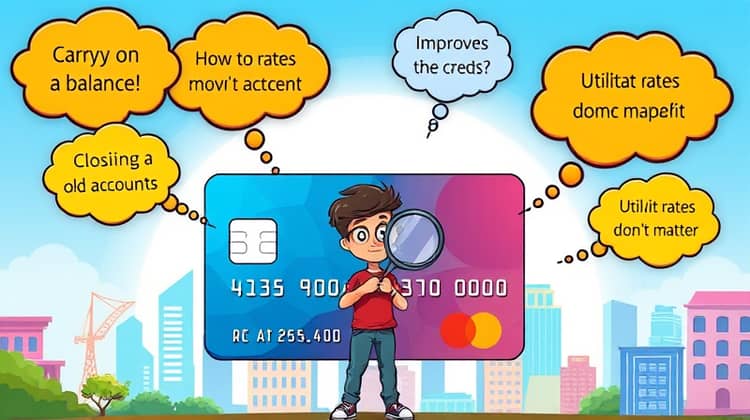Credit Card Utilization Rate: Unlocking the Key to Maximizing Your Credit Score

In today's financially driven world, maintaining a robust credit score is crucial for achieving various financial goals. Whether you're looking to apply for a mortgage, secure a personal loan, or even rent an apartment, your credit score plays a significant role. Among the many factors that influence your credit score, the credit card utilization rate stands out as an essential metric that individuals often overlook.
Credit card utilization refers to the percentage of your available credit that you are currently using. This rate is not only a vital component of your credit score but also a clear indicator of your credit management habits. Maintaining a lower utilization rate can demonstrate responsible credit behavior, ultimately maximizing your creditworthiness in the eyes of lenders.
In this article, we'll explore the intricacies of credit card utilization rates, why they matter, how to calculate them, and tips on managing them effectively to enhance your credit score. Understanding these elements will empower you to take control of your financial profile and make informed decisions on your credit usage.
Understanding Credit Card Utilization

To grasp the significance of credit card utilization, one must first understand what it entails. Credit card utilization is the ratio of your credit card balances to your credit limits. For example, if you have a total credit limit of $10,000 across all your cards and a current balance of $2,000, your utilization rate is 20%.
Lenders typically look at your utilization rate to gauge your credit risk. A high utilization rate may signal to lenders that you are over-reliant on credit and could be at risk of defaulting, while a low rate generally indicates that you manage your credit responsibly and have the ability to pay off your balances.
It is essential to highlight that your utilization rate is not only calculated on an aggregate basis but also on an individual card basis. This means that even if your overall utilization rate is low, if you have one card maxed out, it could still negatively impact your credit score.
Why Utilization Rate Matters

The utilization rate is one of the most significant factors in determining your credit score, often accounting for about 30% of your total score. Lenders use this metric to assess how much available credit you are utilizing, which can indicate how financially responsible you are.
A lower utilization rate is typically more favorable as it suggests that you are using credit wisely and are not financially overextended. Lenders view this behavior as less risky, making it crucial for anyone looking to build or maintain a good credit score.
- A high utilization rate can lead to a lower credit score.
- Keeping your utilization rate below 30% is generally considered good practice.
- Credit utilization is frequently updated and affects your score in real-time.
Ultimately, understanding the importance of your utilization rate can help you make smarter financial decisions and ensure better outcomes when applying for credit.
How to Calculate Your Utilization Rate

Calculating your credit card utilization rate is straightforward and can be done by simply following a few steps. First, you need to sum up the outstanding balances on all your credit cards. Next, you'll need to calculate your total credit limits by adding up the limits on each of your credit cards. Once you have these two numbers, you can use the formula to determine your utilization rate.
The formula for calculating your credit utilization rate is: (Total Credit Card Balances / Total Credit Limits) x 100. For example, if your total balances add up to $3,000 and your total credit limit is $10,000, your utilization rate would be (3000/10000) x 100 = 30%.
- Make a list of all your credit cards and their current balances.
- Add up all your credit card balances to get the total credit card balance.
- List all your credit limits for each credit card and add them up for the total credit limit.
- Apply the formula: (Total Credit Card Balances / Total Credit Limits) x 100 to find your utilization rate.
Calculating and monitoring your credit utilization rate regularly can help you stay on top of your credit score and make necessary adjustments to keep it healthy.
Tips to Manage Your Utilization Rate

Managing your credit card utilization rate effectively can lead to a higher credit score over time. One of the simplest ways to do this is to pay off your balances strategically every month. This practice not only lowers your utilization rate but also helps you avoid interest charges.
Furthermore, consider requesting a credit limit increase on your cards, as this can also help lower your utilization rate, provided you don’t increase your spending simultaneously.
- Make timely payments to avoid accruing unnecessary balances.
- Request credit limit increases on your existing credit cards.
- Limit the number of new credit applications as each inquiry can impact your score.
- Pay down existing balances more aggressively, focusing first on the cards with the highest balances.
By implementing these strategies, you can maintain a healthy credit utilization rate, which will positively reflect on your credit score.
Utilization Rate and Different Scoring Models

Different credit scoring models may weigh credit card utilization differently, which is crucial for consumers to understand. For instance, while the general consensus in the credit industry is to aim for a utilization rate lower than 30%, some models may be stricter and view rates above 10% as concerning. This variance can affect not only your credit score but also your chances of being approved for loans or credit.
Models like FICO and VantageScore take utilization into account but may have different thresholds that could impact your overall score. It's essential to be aware of these differences, especially if you are actively seeking credit, as it can help you strategize your financial approach accordingly.
Furthermore, continuous monitoring of your credit utilization rate allows for timely adjustments based on the scoring model being employed, thus maximizing your credit score potential.
Common Myths About Credit Card Utilization

There are several myths surrounding credit card utilization that can misguide consumers in managing their credit. One prevalent misconception is that carrying a balance from month to month is beneficial for your credit score. In fact, maintaining a $0 balance is preferable and does not harm your score.
Another myth is that closing unused credit cards will improve your utilization rate. In reality, closing an account can diminish your total available credit, inadvertently increasing your utilization rate.
- You should always carry a balance to build credit.
- Closing old credit accounts improves your score.
- Utilization rates aren't important as long as you make payments.
Understanding these myths can prevent unnecessary financial decisions that could negatively impact your credit score.
Conclusion

In conclusion, your credit card utilization rate is a significant factor that affects your credit score and understanding its nuances can prove beneficial as you navigate through various financial decisions. Maintaining a low utilization rate demonstrates responsible credit use, enhances your creditworthiness, and can lead to better financing options in the future.
Being proactive about managing your credit utilization through smart practices, calculations, and debunking common myths can empower you to optimize your credit score effectively. As you continue on your financial journey, remember that knowledge and action are your best tools in achieving your credit goals.






